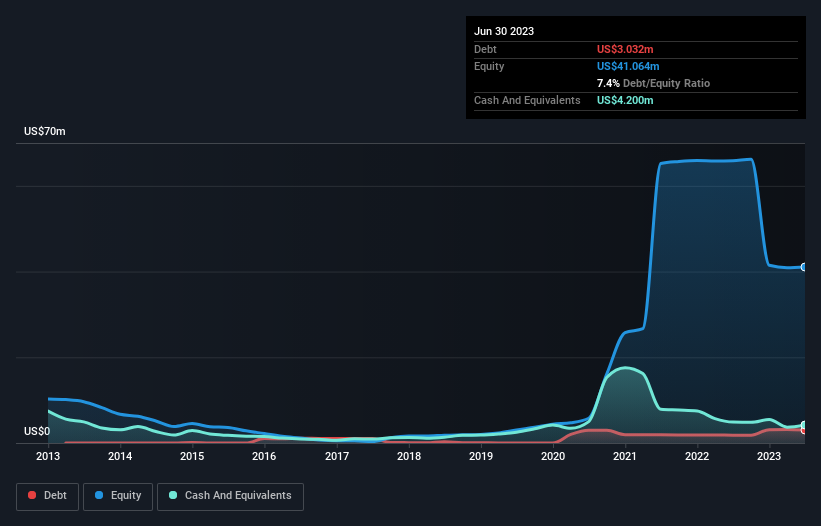The external fund manager backed by Berkshire Hathaway's Charlie Munger, Li Lu, makes no bones about it when he says 'The biggest investment risk is not the volatility of prices, but whether you will suffer a permanent loss of capital.' When we think about how risky a company is, we always like to look at its use of debt, since debt overload can lead to ruin. We note that Crexendo, Inc. (NASDAQ:CXDO) does have debt on its balance sheet. But the real question is whether this debt is making the company risky.
When Is Debt Dangerous?
Debt and other liabilities become risky for a business when it cannot easily fulfill those obligations, either with free cash flow or by raising capital at an attractive price. In the worst case scenario, a company can go bankrupt if it cannot pay its creditors. However, a more common (but still painful) scenario is that it has to raise new equity capital at a low price, thus permanently diluting shareholders. Of course, plenty of companies use debt to fund growth, without any negative consequences. When we examine debt levels, we first consider both cash and debt levels, together.
Check out our latest analysis for Crexendo
What Is Crexendo's Net Debt?
You can click the graphic below for the historical numbers, but it shows that as of June 2023 Crexendo had US$3.03m of debt, an increase on US$1.84m, over one year. However, it does have US$4.20m in cash offsetting this, leading to net cash of US$1.17m.

How Healthy Is Crexendo's Balance Sheet?
Zooming in on the latest balance sheet data, we can see that Crexendo had liabilities of US$9.64m due within 12 months and liabilities of US$3.38m due beyond that. Offsetting these obligations, it had cash of US$4.20m as well as receivables valued at US$4.28m due within 12 months. So it has liabilities totalling US$4.53m more than its cash and near-term receivables, combined.
Of course, Crexendo has a market capitalization of US$44.7m, so these liabilities are probably manageable. However, we do think it is worth keeping an eye on its balance sheet strength, as it may change over time. Despite its noteworthy liabilities, Crexendo boasts net cash, so it's fair to say it does not have a heavy debt load! The balance sheet is clearly the area to focus on when you are analysing debt. But it is future earnings, more than anything, that will determine Crexendo's ability to maintain a healthy balance sheet going forward. So if you're focused on the future you can check out this free report showing analyst profit forecasts.
In the last year Crexendo wasn't profitable at an EBIT level, but managed to grow its revenue by 31%, to US$46m. With any luck the company will be able to grow its way to profitability.
So How Risky Is Crexendo?
Although Crexendo had an earnings before interest and tax (EBIT) loss over the last twelve months, it generated positive free cash flow of US$1.2m. So taking that on face value, and considering the net cash situation, we don't think that the stock is too risky in the near term. The good news for Crexendo shareholders is that its revenue growth is strong, making it easier to raise capital if need be. But we still think it's somewhat risky. The balance sheet is clearly the area to focus on when you are analysing debt. However, not all investment risk resides within the balance sheet - far from it. For instance, we've identified 4 warning signs for Crexendo that you should be aware of.
If you're interested in investing in businesses that can grow profits without the burden of debt, then check out this free list of growing businesses that have net cash on the balance sheet.
New: AI Stock Screener & Alerts
Our new AI Stock Screener scans the market every day to uncover opportunities.
• Dividend Powerhouses (3%+ Yield)
• Undervalued Small Caps with Insider Buying
• High growth Tech and AI Companies
Or build your own from over 50 metrics.
Have feedback on this article? Concerned about the content? Get in touch with us directly. Alternatively, email editorial-team (at) simplywallst.com.
This article by Simply Wall St is general in nature. We provide commentary based on historical data and analyst forecasts only using an unbiased methodology and our articles are not intended to be financial advice. It does not constitute a recommendation to buy or sell any stock, and does not take account of your objectives, or your financial situation. We aim to bring you long-term focused analysis driven by fundamental data. Note that our analysis may not factor in the latest price-sensitive company announcements or qualitative material. Simply Wall St has no position in any stocks mentioned.
About NasdaqCM:CXDO
Crexendo
Provides cloud communication platform software and unified communications as a service in the United States and internationally.
Flawless balance sheet with solid track record.
Similar Companies
Market Insights
Community Narratives



